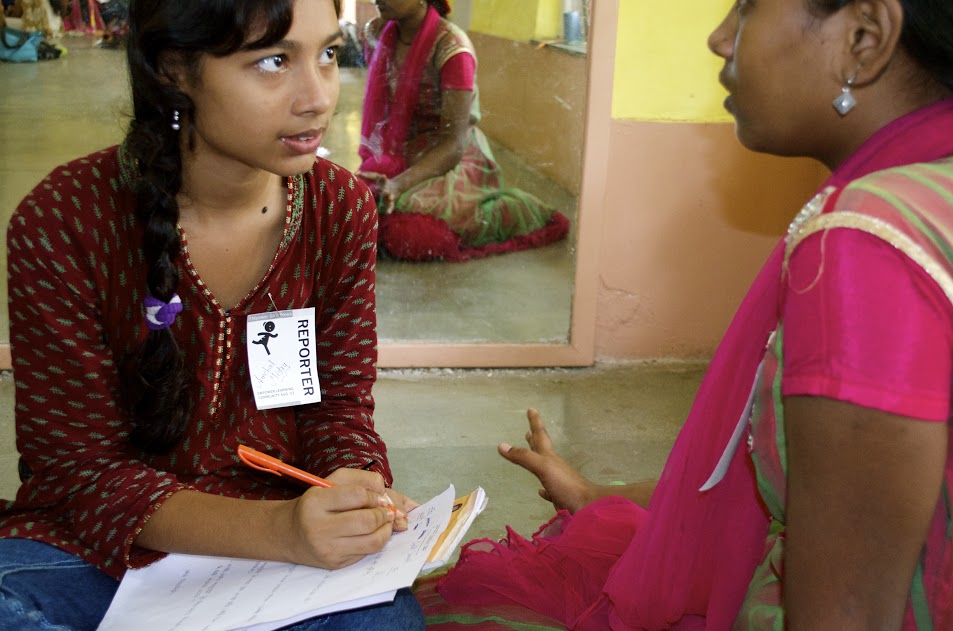In 2006 – before the United Nations declared 11 October International Day of the Girl Child, before Malala Yousafzai’s courage brought her the Nobel Peace Prize, before anti-rape protests erupted in India – only a few grassroots organizations were reaching adolescent girls on issues as diverse as safety, schools, literacy and legal rights. These organizations were often operating in isolation, unrecognized by larger institutions and in a constant struggle to secure funding.
That year, six grantmaking organizations – American Jewish World Service, EMpower–The Emerging Markets Foundation, Firelight Foundation, Global Fund for Women, Mama Cash and Global Fund for Children – formed the Grassroots Girls Initiative (GGI), with $20 million from the Nike Foundation. Over eight years, the initiative evolved from finding and funding grassroots solutions to working as a ‘community of practice’ that forged links between grassroots organizations and built on members’ learning and approaches.
The case for communities of practice
For GGI, connecting grassroots organizations for co-learning and exploitation of synergies was a solution to common grassroots challenges, including duplication of effort, limited reach, isolation leading to burnout, lack of exposure to new ideas, and ineffective practices. From 2011 to 2014, each GGI member created and supported a different community of practice, bringing together its grassroots partners to learn from one another, testing and using different models and approaches.
Shifting the paradigm on funding girl-led groups
Mama Cash convened women’s funds and girl representatives from across the globe. Their collective insight that successful girl-focused programmes must be designed together with girls led to a greater emphasis on supporting girl-led groups. Many of the women’s funds embraced the Central American Women’s Fund’s model, involving girls in grantmaking processes or adding them as advisers to their boards. After two years, the number of women’s funds funding girl-led groups had doubled from four to eight.
Demonstrating expertise for increased influence
One of the organizations in a learning community set up by Firelight Foundation in Rwanda conducted research in its community on adolescent pregnancy and used the data to design a programme. Their expertise was passed on to other members of the learning community so that district officials now consult them on how to deal with teen pregnancy.
Catalysing research for action
A learning community of 26 organizations set up by American Jewish World Service (AJWS) in Nairobi, Kenya conducted a baseline study with adolescent girls aged 10–19. Of the 255 girls interviewed, over 20 per cent were in multiple sexual relationships; 19 per cent, most under 18 years old, were engaged in commercial sexual activities; and 24 per cent had experienced coerced or forced sex. Armed with this data, community members have demonstrated at health centres, spoken to local leaders to ensure that cases of gender-based violence against girls were taken seriously, and advocated nationally for sexual and reproductive rights for adolescent girls.
Building girls’ leadership across social and cultural differences
EMpower’s learning community in Mumbai brought together adolescent girls and young female staff mentors from grassroots organizations representing four populations: Muslim, tribal, internal migrant, and native Maharashtran communities. The girls chose the issues they most wanted to address in their communities: reducing superstitions and stigma related to menstruation; creating awareness about and reducing sexual harassment; and decreasing restrictions on girls’ mobility and participation in public life.
Over 80 girls took on these issues in their communities, organizing events such as flash mobs to call attention to the right to safe mobility, and creating watch groups to reduce sexual harassment in schools. After a year, the learning community expanded to three new organizations and doubled the number of girl leaders participating. Pre- and post-activity evaluations showed girl participants greatly increased their self-confidence, speaking power and awareness of their rights.
Creating safe spaces to challenge assumptions
The Global Fund for Children set up a learning community to provide a safe space in which to confront bias. Eighteen grassroots partners from South Asia and East Africa tackled their own biases about adolescent girls. They brought to the surface assumptions about topics such as girls’ self-expression and gender roles inside and outside the home, and then they examined how these affected programme design and outcomes.
Building a virtual community
In the last three years, Global Fund for Women (GFW) tested an online learning community as a cost-effective way to help ten organizations scattered across five regions share successful strategies and get advice from committed activists working on similar issues. This approach was particularly important for groups that were the only ones in their area addressing adolescent girls’ issues. Initially, GFW posed questions for the organizations to answer on the site. Later, the organizations took turns in leading discussion topics. Differing levels of comfort with the technology, language barriers and time pressures affected groups’ engagement, however. Email provided the richest discussion channel for some, suggesting that the site could have been more user-friendly.
Key lessons
While GGI members used different approaches to communities of practice, some universal lessons did emerge.
Ensure the learning community has a shared vision. AJWS’s learning communities initially had no specific goal beyond shared learning, so interest waned. AJWS supported a strategic planning session for the Nairobi learning community, which clarified its future direction, produced an outcome-focused orientation and increased engagement.
Focus on one issue. Just as a sharper focus increased the effectiveness of the Nairobi learning community, the Mumbai learning community is now focusing all energies on increasing safety and public mobility for girls.
Use the opportunity to bridge differences. Without the Mumbai learning community, girls from tribal, migrant and diverse religious communities would probably never have come together and might have continued to harbour prejudices against the ‘other’. Once together, the girls developed bonds around the common experience of being a girl and the shared success of creating change in their communities.
Joint capacity building is effective and cost-efficient. Small organizations often lack the staff and hence the range of skills to deal with complex issues and organizational management. A trusted community of practice can enable small organizations to borrow or adapt others’ processes and procedures. Through joint learning and capacity building, seven young female staff members from organizations in the Mumbai learning community learned new skills they could apply in their own institutions.
‘A trusted community of practice can enable small organizations to borrow or adapt others’ processes and procedures.’
Communities of practice need cultivation, coordination and commitment. All the learning communities found that without sustained participation by all members and shared expectations about participation, engagement will diminish or become lopsided. Open conversations about engagement and roles are needed from the outset.
Funder roles need to be revisited continually. The staff of GGI member organizations took more active roles during the start-up phases of the communities of practice than initially envisioned, ranging from facilitating meetings to counselling on inter-institutional frictions to providing direct technical assistance and training. Programme officers needed to continually reassess their role with the learning community.
Small and local organizations especially benefit from the multiplier effect. Community-based organizations can use the power of networks to amplify their messages and multiply their actions. When grassroots organizations connect with each other, it provides them with different strengths, as well as moral support in challenging circumstances.
The GGI legacy
The GGI was also a community of practice for the funder members themselves. Through its semi-annual meetings, they learned new approaches and derived new lessons. While GGI ended as a formal funding initiative in 2014, each member remains committed to the idea that grassroots organizations are a force for transformation in the lives of adolescent girls and armed with new means to continue the work.
‘The biggest legacy of the initiative is, as Amy Babchek of Nike said, that “the grassroots landscape for girls is immeasurably stronger than it was when we started in 2006”.’
The biggest legacy of the initiative is, as Amy Babchek of Nike said, that ‘the grassroots landscape for girls is immeasurably stronger than it was when we started in 2006’. Through networking and collaboration, six intermediaries and 300 organizations reached over 400,000 girls, including some of the most vulnerable populations: trafficked adolescent girls, disabled girls, ethnic and religious minorities, street-based girls, single teen mothers, sexual assault survivors, migrants and refugees.
Cynthia Steele is executive vice president of EMpower–The Emerging Markets Foundation. Email csteele@empowerweb.org
Victoria Dunning is executive vice president of Global Fund for Children. Email vdunning@globalfundforchildren.org





Comments (0)